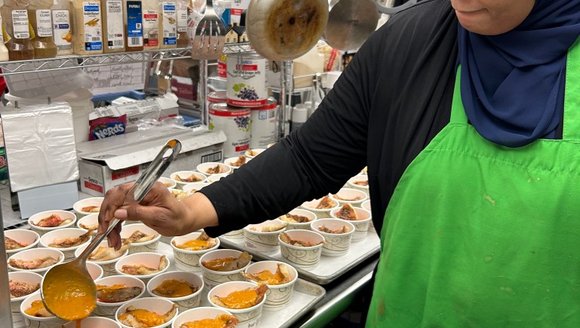Sea to School
Connecting New England's schools with local seafood.
One of our sustainable seafood team’s goals is to increase the amount of local seafood served in public school cafeterias across New England. This work aims to improve access to local seafood by establishing a comprehensive sea to school program focused on the Gulf of Maine region.
Sea to School Goals:
- Increase the amount of local seafood served in schools in New England by partnering with school foodservice staff and student ambassadors.
- Develop culturally diverse local fish recipes to provide immigrant students and students from diverse backgrounds with familiar flavors and preparations.
- Develop and strengthen education around local seafood in schools throughout New England.
Sea to School Projects
Explore the different ways we are working to bring local seafood to cafeterias in New England.
-
![Local Seafood in New England's K-12 Schools]()
Local Seafood in New England's K-12 Schools
Our sustainable seafood team received a 2020 USDA Farm to School grant to work with K-12 schools across New England to increase the amount of …
-
![Connecting Cafeterias to Culture and the Classroom]()
Connecting Cafeterias to Culture and the Classroom
In collaboration with South Portland Public Schools, Westbrook Public Schools, Chef Samantha Cowens-Gasbarro, and community consultant, Khadija Ahmed, we are building demand for and increasing …
-
![Local Seafood Student Ambassadors]()
Local Seafood Student Ambassadors
In the 2021–22 school year, GMRI is partnering with students from five colleges and universities across New England to boost local seafood consumption in their …
Why seafood in schools?
Seafood is a healthy protein, rich in nutrients like vitamins A and D and omega-3 fatty acids — all of which are important for the growth and development of healthy kids.
Many of the schools we work with have high percentages of students that receive free and reduced lunch, and on average, students get about one-third of their daily caloric intake from public school lunch programs, so serving up seafood is a great opportunity to meet students’ nutritional needs. K-12 schools are also a largely untapped market for local fishermen, making this a win-win for our communities.
Why local?
Many fisheries in our region are healthy and abundant, yet several species are under-harvested due to the lack of market demand and tough competition with imported seafood. Prioritizing local seafood not only helps to support local fishermen, but also has rippling economic impacts throughout the supply chain to dockside businesses like ice houses, gear businesses, seafood processors, and grocers and restaurants in our communities.
The Opportunity
Currently, 91% of the seafood consumed in the US is imported, but we can make a dent in that number by increasing local seafood sales in our region, including in New England's K-12 schools. Currently, less than 30% of New England’s K-12 schools serve local seafood. By serving local seafood in schools, students are offered a nutrient-dense, climate-friendly protein that not only is super healthy but is also responsibly harvested and supports our local communities and economy.






